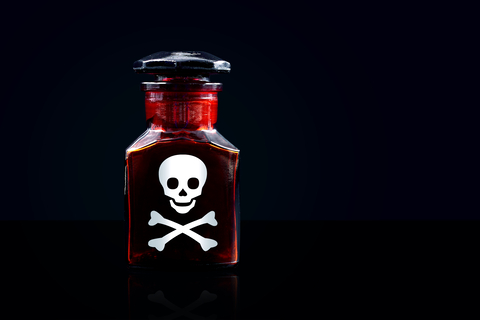A PRACTICAL GUIDE TO POISONING
Growing up, I always knew that one day I’d kill someone with poison.
That was partly because I was fascinated by Agatha Christie novels, in which poison often plays a prominent role. Alfred Hitchcock used it to wonderful effect in his films — think of how Ingrid Bergman was poisoned by her husband in Notorious, and of Joan Fontaine wondering if her husband had it in for her in Suspicion. Other films, like Arsenic and Old Lace, represented poisoners as dotty yet sweet characters. I was also an avid reader of history books about the Roman Empire and Renaissance Italy, and poisonings played a major role in both time periods, reshaping the events of the day and, ultimately, history itself.
Poison seemed like such a democratic way to dispatch someone. After all, you don’t need to be strong or have any particular skill with weaponry. The killer could be young or old, healthy or infirm. It seemed almost easy.
It was only when I decided to poison someone—in a book, to be clear—that I discovered how fiendishly difficult it actually is. When I started to examine how different poisons work, I realized I was in trouble. Poisoning a person isn’t necessarily hard to do, but avoiding the signs of a poisoning is tough. Sure, you can get rid of someone with arsenic, but all a coroner has to do is look at the victim’s hands to know what’s happened. That wasn’t what I wanted at all, so I had to find ways around it.
Because of writing several books and short stories in which poison plays a key role, I’ve learned a lot about the art of poisoning. Here are some things to keep in mind when writing about it:
- Poisoners need no physical strength, but they must have nerves of steel. Shooting or stabbing someone takes a mere moment, whereas poison requires dedication. Many poisons require a certain amount of time to work — often it’s days, but it could be a week or more — and the poisoner must administer several doses of poison. Given that the poisoner normally needs to be in close proximity to his or her victim, this means that the killer has to be able to look into the eyes of their victim, engage them in conversation, perhaps even be affectionate with them — all the while knowing that they’re killing this person.
- The most common poisons aren’t what you think. Cyanide, arsenic, and strychnine are some of the poisons readers encounter in fiction. In reality, the most common poison used today is antifreeze (ethylene glycol). It’s sweet, mixes well with certain liquids, and is tough to detect unless poisoning is suspected (it damages certain organs and leaves evidence that would be obvious in an autopsy).
- Exotic poisons can be more trouble than they’re worth. Importing exotic poisons (and there are several amazing, hard-to-detect ones in South America… but I digress) only leaves a trail for the authorities to follow. After all, the more exotic the poison, the smaller the circle of people who can access it. The problem with something uncommon is that it’s not easy to use and will require intense research, which in turn will provide a lead for any intelligent detective or PI who’s on the case.
- Smart poisoners work with what they’ve got. The clever killer looks for drugs that are already in the victim’s medicine cabinet, and that are not, in prescribed doses, deadly. One of my more inspired killers used Viagra this way (an overdose can cause a heart attack). Also, some prescription drugs do not play well with others. Read medical warning labels to get an idea of what not to do… so that when you’re writing about a poisoner, you know what kind of damage they can cause.
- Poisons can be used in ways that aren’t deadly. Every prescription pill comes with its own list of warnings and interactions. You can render someone dizzy or dopey via a bad interaction, making a character vulnerable to a bad influence, or more prone to having an accident. Drugs that regulate, stabilize or enhance one’s mood can be used to control a character’s actions, and make them do things they wouldn’t normally do. But even an over-the-counter allergy pill can knock someone out, so there are plenty of possibilities.
Writing about poisons has made me expand my definition of what a poison can be. I think that’s true of my readers, too. One reviewer wrote that, after reading one of my books, he’d never even look at aspirin the same way. Honestly, I take that as a compliment.
Hilary Davidson is the bestselling author of six crime novels, including One Small Sacrifice and The Damage Done. Her latest book, Don’t Look Down, will be published by Thomas & Mercer on February 11, 2020. Her short stories have appeared in Thuglit, Ellery Queen, and just about everywhere in between. The winner of two Anthony Awards and a Derringer Award for her crime fiction, she is also a journalist


